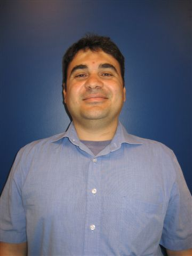Soft-lithographic patterning of functional oxide and composite materials
Promotion date: 30. June 2010
Promotors: Prof. Dr. Ing. Dave Blank
Assistant Promotor: Dr. Ir. Andre ten Elshof
| This thesis work addresses low-cost micron and submicron-scale parallel patterning methods, with emphasis on the formation of patterned thin films of metal oxides and organic/inorganic hybrid materials. The materials can be deposited and patterned from liquid precursors, such as sol-gel solutions and colloidal suspensions. The derived materials were successfully patterned with resolutions from tens of micrometers down to 100 nm, obtaining lines, pillars and pit patterned films. |
Are new techniques involved in your thesis project?
Soft lithography patterning started in the 1990’s. My work was to establish these techniques even further. It is a very cheap alternative to photolithography. The processes can go parallel and structures are thinkable far under the natural barrier of 100 nm, as it exists in photolithography.
The techniques are there. My approach was to apply these techniques while using sol-gel solutions, however there is unwanted shrinkage associated to such materials.
Sol-gel markers were not new to me when I came to Mesa+. In my master project in Kiel, Germany I participated in a group on this subject matter.
Was there a decisive moment in the project?
My supervisor Andre ten Elshof advised me to work on two or three subject matters simultaneously, right from the start. That was a good starting point. On top of that I had good results in all three techniques.
The first goal to build a 3D layer-to-layer structure, I achieved very quickly. This principle can be used for applications like waveguides.
Using innovative patterning methods, I achieved structures even in the range of 100 nm. Downsizing is an important technological trend in all kind of industrial applications nowadays.
Some publications came out of this work. One review in the Journal of the European Ceramic Society (JECS), and also in the Journal of the ACS Applied Materials and Interfaces.
What did you learn especially during your thesis project?
One learns a lot! For example, not to start a project from one angle, but setting up two or three kinds of experiments at the same time. Also, multitasking is an important feature of scientific research, be it: surveying techniques, working independently, developing presentation skills, working goal-oriented and organizing one’s work in months, weeks, even days.
Were a lot of groups involved in your work?
At Mesa+ we worked closely together with many groups, for example the BIOS-group, cleanroom technicians and utilizing various analysis techniques at Mesa+. With the group of Prof. dr. Uwe Karst at the university of Münster we collaborated also. Furthermore, some experiments were carried out at ESRF, Grenoble.
Mesa+ is one of the best institutes on nanofabrication. It is improving in many directions in my opinion: the pace of research, the growing of groups and connections with industry. I recommend the institute to all researchers. The transfer of knowledge is quite good also.
What are your future plans?
I like to work in the industry, in the area of materials science, where I can apply my scientific and engineering skills on solving problems. This feature of the work I like very much. In five years time I hope to build my own projects, using my own ideas.

